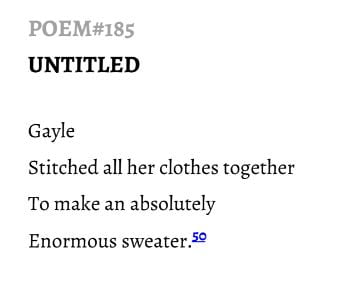This poem is a funny dumb-humor nonsense poem that can be applied to many situations in real life, and is just a step back and recognition of the cyclical nature of life. It starts with Anderson having a goal/purpose, completing it, and then seemingly out of nowhere, having a change of heart for no reason and without question beginning on his new task. The drone-like task to task repetition can be attributed to the average American 9-5. Showing the useless and monotonous nature of most full-time jobs. The second poem is an actually serious poem reflecting the choices and consequences of life. It portrays the conflict between decisions and outcomes very well, painting a picture on how our lives are just made up of these decisions that we sometimes overthink. The first poem shows how not thinking about the results can sometimes get you stuck in a worse situation, especially when Anderson “jumped down”, symbolizing a point of no easy return almost. “I could not travel both” stated in “The Road Not Taken” signifies the definite decision much like the first essay. It relates to our seemingly permanent/no way back now attitudes with certain real-life choices, ex. Buying a House, Taking out a loan. These choices seem like one-way decisions, and these poems both illustrate those thoughts perfectly. They also both go over the themes of reflection, in the first “wanted to climb back” signifies wanting to change a past decision, or wishing you could go back. The ending of “gathering materials” shows that to undo such choices, work must be done, and prior thought probably could’ve made the headache avoidable. In the second, “perhaps the better claim” illustrates thinking ahead, and maybe affecting the decision at hand. The theme of pure reflection is apparent in the second essay at the end when Frost states “I took the one less traveled by, And that has made all the difference”. This is a moment of reflection, not of a good or bad decision, just one that the author did not regret making. It also represents a ‘leap of faith’ attitude, and how taking the path that not many take can sometimes lead to better or just more pleasurable results. The cyclical and repetitive nature of both these poems also represents the human condition of coming up to a problem, working through it, just to be faced with another. This obstacle is represented by the wall in the first poem, and the fork in the road in the second. These obstacles can also be seen as decisions that might be hard to make. There is also a contrast in the two ways these characters make decisions. In the first poem, Anderson is driven by pure impulse and has a lack of thinking ahead or just necessity in general. On the other hand the character in Frosts’ poem has a clear choice, but it is more focused on the weight of the decision, and the complexity of the task at hand.
500 words
‘
“Image generated by OpenAI’s DALL·E based on user input, March 2025.”





